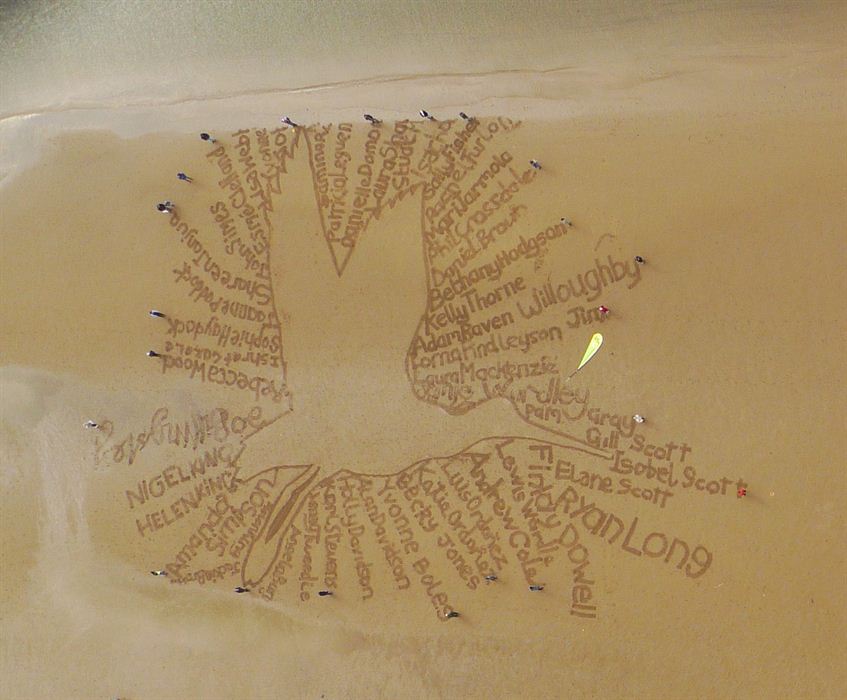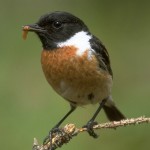Gordon Riddle’s new book Kestrels for Company is soon to be published by Whittles Publishing. Please go to the web site for more details and to order a copy. Readership: Kestrels for Company will appeal to a wide audience including all those with a special interest in raptors, birding enthusiasts, and everyone interested in nature and conservation.
Hunterston Sand Art

As you all know, the Hunterston area attracts a large number of birds especially waders and wildfowl and is one of the most important sites in the county for birds such as Greenshank and Bar-tailed Godwit to name but few. Not forgetting rarities such as Little Egret, Garganey, and Blue-headed Wagtail. Needless to say the proposal to build a coal fired power station on this SSSI site would have a devastating impact. In late September 2010 a team of three sand artists, led by Jamie Wardley, and around 0 volunteers turned Irvine beach into a sweeping range of wading bird silhouettes outlined with the names of objectors to the proposal. Coverage of the event was widespread, with Jamie’s second design of a child’s face surrounded by cracked earth, appearing in publications such as The Times, The Scotsman, The Metro and even the San Francisco Chronicle! If you would like to add your voice to our campaign then please visit www.rspb.org.uk/hunterston
RSPBs Volunteer & Farmer Alliance Project
Would you like to make the most of your bird ID skills and take part in one of the UK钒s most important conservation projects?
RSPB’s Volunteer & Farmer Alliance Project (V&FA) is a UK wide project which offers farmers and crofters free farmland bird surveys. Since it first started more than 10 years ago, over 5000 farms have been surveyed across the UK. Over 500 farms have been surveyed in Scotland, and we look to survey approximately 120 farms in Scotland each year.
Stonechat January 2011
The Stonechat is the magazine of the Ayrshire branch of the SOC. It is now being edited by Tony Scott and is available now for download ![]() in lovely colour. This edition covers the Branch helping celebrate the 75th anniversary of the SOC with a project to encourage young children to watch birds; the first in a new series by Angus Hogg on getting the most out of birding locations; a detailed, envy-invoking report on recent trips by Ayrshire Birders Abroad; and the latest news.
in lovely colour. This edition covers the Branch helping celebrate the 75th anniversary of the SOC with a project to encourage young children to watch birds; the first in a new series by Angus Hogg on getting the most out of birding locations; a detailed, envy-invoking report on recent trips by Ayrshire Birders Abroad; and the latest news.
Water Rail at SWT Knockshinnoch
The frozen SWT reserve at Knockshinnoch had a grand total of 7 birds today: one Heron, 2 Mallard, Teal and one Water Rail. The latter gave one of the best views I’ve ever had as it ventured out onto the partially melting ice to feed. It came within 3m and totally ignored me and a mad Springer Spaniel. I managed to get a couple of shots and a bit of video (with a compact camera, so don’t expect BBC HD). As this was the first photo of a Water Rail I even managed to get an entry on the Ayrshire Species List – which just shows that anyone can do it with a bit of luck!
Wetland Bird Survey in Ayrshire
The survey began in 1947 and today there are around 3000 volunteer counters who participate in synchronised monthly counts at wetlands of all habitat types, mainly during the winter period.
WeBS is a partnership between:
- British Trust for Ornithology;
- Royal Society for the Protection of Birds;
- Joint Nature Conservation Committee (the latter on behalf of Natural England, Scottish Natural Heritage, the Countryside Council for Wales and the Environment and Heritage Service for Northern Ireland) in association with the Wildfowl & Wetlands Trust.
Whilst Ayrshire may not rival some of the larger estuarine areas within Scotland it does have 134km of coastline and numerous inland water sites which fall under the scrutiny of the WeBS. Click on the following link to see coverage within Ayrshire. There are 45 sites registered for Ayrshire and currently only 15 are regularly counted for WeBS, so there is plenty of scope for people to get involved.
WeBS Core Counts
WeBS Core Counts are made annually at around 2,000 wetland sites of all habitats. Monthly co-ordinated counts are made, mostly by volunteers. The principal months of data collection are from September to March although, increasingly, observations are submitted from the summer months also.
How do we collect the data?
- WeBS Core Counts are made using so-called “look-see” methodology (Bibby et al. 2000), whereby the observer, familiar with the species involved, surveys the whole of a predefined area.
- Counts are made at all wetland habitats.
- Numbers of all waterbird species, as defined by Wetlands International (Rose & Scott 1997), are recorded. In the UK, this includes divers, grebes, cormorants, herons, Spoonbill, swans, geese, ducks, rails, cranes, waders and Kingfisher.
- Counts of gulls and terns are optional.
- In line with the recommendations of Vinicombe et al. (1993), records of all species recorded by WeBS, including escapes, are collected to contribute to the proper assessment of naturalised populations and escaped birds.
- Species present in relatively small numbers or dispersed widely may be counted singly.
- The number of birds in large flocks is generally estimated by mentally dividing the birds into groups, which may vary from five to 1,000 depending on the size of the flock, and counting the number of groups.
- Notebooks and tally counters may be used to aid counts.
- Counts are made once per month, ideally on predetermined “priority dates”. This enables counts across the whole country to be synchronised, thus reducing the likelihood of birds being double counted or missed.
How do we record the data?
Once the data has been collected there are a number of ways to record it:
- Firstly, the traditional method has been to record your sighting on a hard copy WeBS form. Once the seasons count have been completed the form gets sent to the Local Co-ordinator who passes on all of the information directly to the WeBS office at the BTO.
- The second method is one more in line with modern technology in that the individual records their observations directly onto the WeBS website. This reduces the need for paper copies, cuts out expenditure on postage and allows the individual to use the website tools to look at things like distribution and number of birds seen for your personal WeBS patch. We are encouraging people to use this second option but for those without regular access to the internet the first option remains open.
Benefits of on-line recording include:
- Paper free storage to record your sightings;
- Easy access to your data;
- Electronic quick searches of your data;
- Easy production of graphs with your data.
If you are interested in getting involved go to the WeBS website for further information or contact the local WeBS Co-ordinator.
References
- Bibby, C.J., Burgess, N.D., Hill, D.A. & Mustoe, S. (2000) Bird Census Techniques. Second Edition, Academic Press, London.
- Rose, P.M. & Scott, D.A. (1997) Waterfowl Population Estimates. Second Edition Wetlands International Publ. 44, Wageningen, The Netherlands.
- Vinicombe, K., Marchant, J. & Knox, A. (1993) Review of status and categorization of feral birds on the British List. British Birds, 75: 1-11.
Waxwing Invasion
Angus Hogg has sent in a nice set of pictures of the recent Waxwing invasion. This group was in Prestwick on 10th November and part of a larger group of birds. Click on the thumbnails below to see the full pictures.
Breeding Stonechats in Ayrshire

Following a prolonged, severe cold period during the second half winter 2009-10, it was obvious that many small birds had suffered a heavy casualty rate. Most inland pairs of Stonechats were wiped out and, based on evidence gathered so far, many of the coastal pairs suffered a similar fate. This kind of thing has happened before, and the species will, doubtless,bounce back. However, it would be useful to know just how bad the situation is prior to the recovery.
I’d be really grateful if anyone with observations of single territorial males, or breeding pairs of Stonechats anywhere in Ayrshire this year could send their records to me (please include the site name and, if possible, a grid reference) before mid November. I’m hoping to write up a short note in the SOC Ayr Branch Newsletter outlining the current breeding status of our county bird. The deadline for inclusion in the newsletter is late November.
Mud, Mud, Glorious Mud
Knockshinnoch Lagoons has plenty of exposed mud at the moment. We lowered the sluices and cleared the vegetation earlier this month to attract the waders in to in front of the hide. I was there today and believe I saw a Black-tailed Godwit. It would be nice to have that confirmed by a “proper birder”. There were also more than 50 Teal and 4 Snipe. I’m sure there were other good things there that the more trained eye would have spotted.
The Stonechat – Now In Glorious Technicolor!
The Stonechat is the magazine of the Ayrshire branch of the SOC. It is now being edited by Tony Scott and is available now for download ![]() in lovely colour. This edition has an update on Irvine Bay developments, BTO Atlas status, a few envy-invoking trip reports and a whole lot more.
in lovely colour. This edition has an update on Irvine Bay developments, BTO Atlas status, a few envy-invoking trip reports and a whole lot more.






